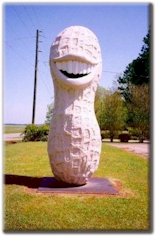After visiting President Carter’s Bible Class at Maranatha Baptist Church in Plains, GA, we had a fantastic meal at Mom’s kitchen on Highway 27. What a great meal of old fashioned southern cooking! Teenage boys eat so much, it is amazing that they remember anything about what they eat – but Joe recommends the “hot hamburger”, a specialty of the restaurant. This is a hamburger dressed with gravy. The fried chicken is excellent.
Fortified with a good meal, we went to the Jimmy Carter Historical Site. You can tour the high school, which is now a museum, and learn about President and Mrs. Carter’s lives growing up and the years in the White House. Our favorite stop, however was President Carter’s boyhood home.
When we entered the yard, we found a park ranger boiling peanuts over an open fire, just as people did in Carter’s youth. (OK, if you have serious “can’t be in the same room with peanuts” allergies, you might want to avoid the open fire, or the gift shops in the area – the main product of Plains is peanuts, remember) The farm is a self guided tour of the house, the tenant buildings, barns, company store, and fields.
Joe was interested in the windmill, which generated power and brought water to the farm. He also was interested to learn that electric power was not available at the farm until the 1930s, when Carter was entering his teens. Various stops on the tour include recordings of Carter explaining how life was lived there. Joe was also interested in the tenant building where the farm manager lived, and Carter’s recorded observations of growing up in a rural racially segregated world. Such a world is unimaginable to Joe.
You can also see the depot which was the campaign headquarters for Carter’s gubernatorial and presidential campaigns – and the infamous “Carter peanut” statue!

The next day, we went to Andersonville, site of the largest Confederate military prison and home to the National Prisoner of War Museum. Joe is very interested in military history and strategy, and is constantly wondering how famous battles would have turned out if only the strategy had gone a different way. This was a dose of reality of war for him – what I found depressing he found uplifting and inspirational. Andersonville is a good place to visit with teens – I would not recommend the prisoner of war museum for younger children.
We toured the stockade site – you can go by car or by foot. Naturally, Joe needed to explore this on foot and up close. Unlike many battle sites, this is one park where you can freely roam the site, up and down the hills and ridges, tracing the little stream that was once rancid with disease and death. If you have an interest in reworking military history, this is a good exercise. Joe is still mulling over how the atrocity of Andersonville could have turned out any different, given the circumstances of the war at that time. There is also a cemetery where the dead were buried by numbers – their names were restored to them after the war thanks to Clara Barton and one of the survivors who had worked in the infirmary and kept detailed secret notes of every death and every burial.
We also toured the historic village of Andersonville. Here we saw the supply depot which had been disabled during the Civil War, and a small museum of artifacts. Joe was intrigued by a commendation given to the commanding officer of Andersonville prison, Captain Henry Wirz, by the Sons of the Confederacy during the 1980s. Since our trip, he has been researching Confederate historical groups, and reading everything he can about the trial and execution of Captain Wirz after the Civil War.
Returning to our hotel in Americus, we stopped for an hour at the Habitat for Humanity Global Village and Discovery Center. We volunteer at a local homeless shelter with our church, and will be repairing homes in Appalachia with a church group this summer. Habitat has an interesting display of the types of homes their affiliates construct all over the world, and models of the terrible shanties that much of the world’s people survive in. We also observed an interactive activity – how to make a brick out of Georgia clay soil. Not so easy! But we were told that once the technique is mastered on many of the global construction sites, the work goes very fast. It truly is a marvel. President and Mrs Carter are often credited with founding Habitat, but they did not; it is a Christian ministry that was started by a group of visionary people. The Carters are among it’s biggest supporters, and certainly the most well known.
To plan your trip, visit the National park service website and the following links:
Jimmy Carter National Historical Site: http://www.nps.gov/jica/pphtml/facilities.html
Andersonville National Historical Site: http://www.nps.gov/ande/
Village of Andersonville: http://www.andersonvillegeorgia.com/
Habitat for Humanity Global Village & Discovery Center: http://www.habitat.org/gvdc/default.aspx
Plains Georgia website: http://www.plainsgeorgia.com

